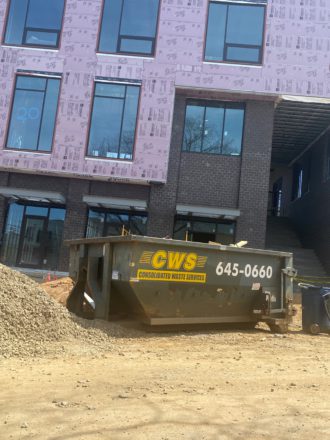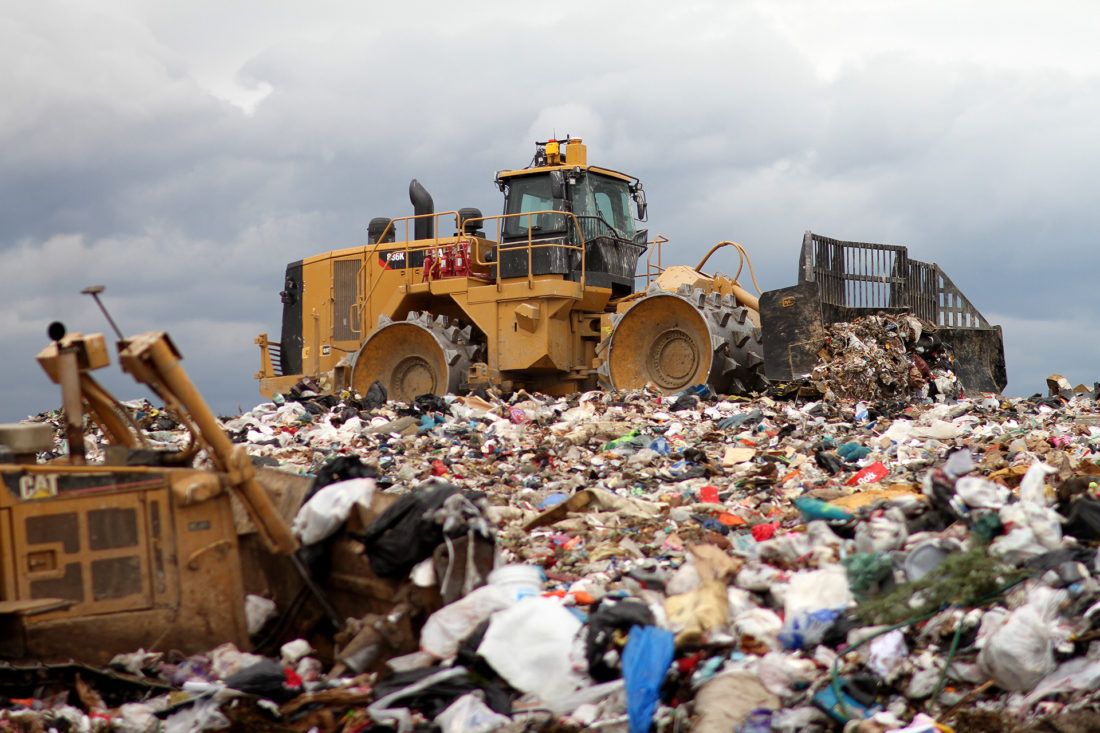In 2014, the city of Asheville made an ambitious pledge: By 2035,the amount of material going into the local landfill would be 50% lower than 2010 levels.
Less than a decade later, that goal has ended up in a dumpster. At the end of 2020, Asheville had increased its municipal city waste by nearly 2.5% compared with the 2010 figures, a far cry from the 15% reduction staffers had projected would be needed by this point to stay on track to meet the city’s goal.
The bump is part of a larger trend. Asheville is growing, and its garbage is growing with it. Fiscal year 2020 saw roughly 184,319 tons of municipal solid waste flow into Buncombe County’s landfill in Alexander from Buncombe County residents — an increase of more than 30 tons over the year prior. Residents living within city limits contributed 24,208 tons that same year.
Buncombe County’s municipal solid waste landfill was built in 1997 and, according to Buncombe County Solid Waste Director Dane Pedersen, has 20-25 years left before it reaches capacity. Waste is currently going into cell six of 10; he predicts that work to develop the next cell will begin in the next year. That’s pretty good for a landfill built with an intended 30-year life span, he says.
The Alexander site is also home to Buncombe County’s construction and demolition landfill, which had 19-24 years before it reached capacity at the time of the last annual survey, Pedersen says. The 2020 fiscal year saw 32,491 tons of C&D waste enter the facility from Buncombe County, a 12-ton reduction from the 44,779 tons that entered in 2017.
All signs indicate that the area’s growth isn’t going to slow down anytime soon. Making good on waste-reduction goals has become significantly harder with more people entering the equation, but local waste management teams say that just means it’s time to double down on their efforts.
More people, more problems
More people moving to the area and more material to manage will take up more landfill space, Pedersen says. To track what’s coming in, the county’s solid waste team has asked commissioners for $100,000 in 2022 capital improvement funds to conduct a waste stream evaluation this fall to assess everything entering the landfill.
“We know the region is experiencing historic growth, but we don’t exactly know how that translates into our waste output,” says Cassandra Lohmeyer, the county’s new recycling coordinator. “The data will really guide us and be a more accurate compass with which we can develop new diversion programs.”
Much of that historic growth is showing up in construction and home renovations, says Morgan Alexander, the vice president of Asheville’s Consolidated Waste Services, a private waste removal company that works with commercial, residential and industrial customers. “It never fazes me to see something new being built on the next street corner,” she says, noting the boom in apartment complexes going up throughout Buncombe County. “I only anticipate for that to rise.”
Constructing a typical home can produce 10,000 pounds (or 5 tons) of waste material, according to a June blog post written by CWS. 2020 was one of the busiest years on record for the company, Alexander says, with operations growing by 6%.
Area population growth poses a host of other ecological problems to consider, says Megan Davis, the recycling and solid waste supervisor at Warren Wilson College. When people buy or build homes on the outskirts of town, garbage trucks have to make longer trips for collection, using more gasoline and generating more air pollution. When the landfill eventually reaches capacity, trash will likely be trucked to a location even farther away, increasing service costs.
And if those costs rise, it becomes harder for lower-income folks to afford waste removal, Davis says, potentially leading to more illegal trash dumping. “It’s a complicated, complicated thing.”
Colleges step up
Area colleges and universities are working to meet their waste reduction goals through ambitious initiatives. In 2017, Warren Wilson committed to diverting 90% of all waste generated on campus from the landfill by 2032, with additional efforts to reach 100% zero waste as new technology becomes available.
Before the COVID-19 pandemic, students and staff were diverting approximately two-thirds of waste from the landfill through campuswide recycling and composting programs. An on-campus Free Store offers donated books, furniture, clothing, cleaning supplies and decor to students, faculty and staff at no charge. Last fall, Davis and her team began creating a Hugelkultur, a layered mound of logs, half-finished and finished compost that increases the fertility of soil to grow native plant species.
Composting is also key to waste reduction goals at UNC Asheville, said Jackie Hamstead, interim co-director of the university’s Office of Sustainability, in an email. Approximately 4,500 pounds of organic material are currently composted each week, down from a pre-COVID weekly average of 7,750 pounds.
Recycling expectations are also written into UNCA’s construction guidelines, Hamstead added. Over 80% of construction waste generated during the recent build of The Woods, an on-campus apartment complex, was recycled or reused; the buildings are also LEED certified by the U.S. Green Building Council.
What comes next?
The findings from the county’s pending waste stream audit will dictate the solid waste team’s next moves, Lohmeyer says. Of the $100,000 requested in the 2021-22 budget, $40,000 will support a composting feasibility study to assess possibilities for future programs.

In 2015, the city and county conducted a joint organics study to quantify the amount of compostable material that ends up mingled with landfill-bound items. The study found that more than a quarter of Asheville’s trash could be used to produce fertilizer. Pedersen wants to take that data and augment it with new information from commercial businesses, other municipalities and unincorporated areas, he told the Buncombe County Board of Commissioners during a Feb. 16 presentation.
Meanwhile, Asheville’s waste reduction goals — which do not take population growth into account — need to be revisited, says Jes Foster, Asheville’s solid waste manager since 2017. The city’s Office of Sustainability and Public Works Department have asked for $300,000 in the 2021-22 operating budget to complete a long-range solid waste master plan. The study would revise and create new waste reduction goals, update programs for equitable service delivery and make fee structure recommendations, Foster says.
The city’s Sanitation Division has also asked for funding to add a waste reduction specialist to oversee recycling, composting and litter management initiatives.
Recycling also remains a focus for both the city and county. The city Sanitation Division encourages residents to use its online “Waste Wizard” tool to determine which items can and can’t be recycled; Lohmeyer is also working to educate “wishful recyclers” who put anything and everything into their blue containers about recycling contamination.
Curbside Management, which processes a significant portion of recycling from Buncombe and the surrounding counties, is ready and able to meet a surge in demand, says co-owner Barry Lawson. At the beginning of 2019, he and his wife, Nancy, completed a $5 million addition to the company’s Woodfin facility and updated 80% of its equipment with newer automated models to speed up the sorting process.
Well-executed policies can be a main driver of waste reduction initiatives, says Davis of Warren Wilson, but all bold changes need to be paired with educational programs and individual accountability to cut down on single-use material consumption.
“We have to do something, now,” she says. “We don’t have any more time to waste. We have to really work together to fix this.”
Editor’s note: The sidebar “Wear, wait, wash — or reduce, reuse, recycle” was corrected to accurately state the number of discarded face coverings referenced in Case Studies in Chemical and Environmental Engineering. The correct number is 2.2 billion, not 2.2 trillion.






Good article. To me it makes another point about whyv the proposed plans to develop Charlotte street is a bad idea. They want to tear down 13 Historic buildings and a restaurant and old growth trees and throw them in the garbage. Wasteful, spoilt , greedy behavior like this has horrible consequences for the planet.
Is the transfer station at 190 Hominy or 24 Pond Road? I noticed what looked like a landfill near the river while driving south on McDowell. TRA$H in ASH is a problem but the county’s focus on new Green policies is reassuring.
One glaring issue hindering both residential and commercial recycling is the huge amount of multi-family housing being built. You can’t have curbside recycling without a curb. Such large dense developments are serviced as commercial buildings by private waste haulers. Even if the hauler is required to “provide recycling”, very few residents are going to remember or care enough to carry both a trash bag and a recycling bag out to the dumpster area. If it costs extra, they definitely won’t do it. The City has done a good job giving people large carts for their recycling, and the County haulers are also using them now. The convenience helps. On the commercial side, most contractors just don’t separate materials and recycle them. I’m constantly amazed at how much valuable metal and wood is discarded at construction sites.
It would take at least 10 years of NONSTOP flights to AVL (based on # of airlines and flights from AVL) to justify 3+million tourists a year. This estimate does not even factor in off and peak seasons. Highway traffic would be at a complete STANDSTILL for miles and years! Parking downtown is surprisingly expensive since it takes no more than 20 mins to walk the entire city. There is NO traffic in AVL compared to other “tourist” cities. People like to walk, jog, and bike solo or even as a group on tours like LaZoom! Apartments, Abnb’s (private room rentals, vacation condos, garage apts) offer many AVAILABLE options. AVL has more RECYCLING alliances, programs, events, and initiatives than any other US city.
Where is all this TRASH IN ASH coming from?
Editor’s (my) Note: The statistics providing the number of hotels and occupancy rates do not support this many tourists or TRASH!
Talking trash is appropriate as I sit in line on a Friday at noon at the buncombe county transfer station, with apparently once again only one employee at the window and nobody taking payment in line. What a shame we don’t have the technology that would make this process run so much more efficiently. Oh wait we do. Buncombe county do better.